Climbing Mount Kilimanjaro is a dream that many adventure enthusiasts hold close to their hearts. This towering mountain is Africa’s tallest and also the world’s highest free-standing mountain, offering an adventure like no other.
However, the path to its peak, Uhuru Peak, isn’t a leisurely stroll. It’s a journey that tests your limits, both physically and mentally. So, how hard is it to Climb Kilimanjaro? Let’s unpack this question with a closer look at what the climb entails.
The Altitude Factor
Firstly, the sheer height of Kilimanjaro at 19,341 feet (or 5,895 meters) is the primary challenge.
- The higher you go, the thinner the air becomes, making it harder to breathe.
- Over half of the climbers experience altitude sickness in some form. This is the most important challenge that most climbers aiming to conquer it face.
- However, altitude sickness doesn’t discriminate; it can affect the fittest climbers just as easily as those less accustomed to physical exertion. The key to success here is acclimatization.
Hence, slower ascents, such as those offered by the Lemosho Route or the Northern Circuit Route, give your body time to adjust to the altitude and thus, improve your chances of reaching the summit.
Training and Physical Readiness
Physical preparation when going for a Kilimanjaro Climb cannot be overstated.
- Although you don’t need to be in peak athletic condition, being in good physical shape will make your journey more enjoyable and feasible.
- Also, the climb involves long days of walking, often with a backpack, over varied terrain.
Hence, regular exercise, focusing on cardio and strength training, can significantly enhance your stamina and resilience, making each step towards Uhuru Peak more manageable.
Mental Stamina
Beyond physical challenges, Climbing Kilimanjaro is a mental game. The summit night is particularly gruelling, often cited as the hardest part of the journey. It’s a test of willpower as much as physical strength.
Hence, maintaining a positive mindset and remembering your reasons for taking on this challenge can keep you moving forward when your body wants to stop.
The Right Gear
The importance of proper gear cannot be overstated. The weather on Kilimanjaro can change rapidly, and temperatures can drop significantly, especially at higher altitudes.
At this point, what you need is a comprehensive Kilimanjaro Packing List that should include warm, layered clothing, sturdy hiking boots, and a comfortable sleeping bag, among other essentials.
Quality gear will protect you from the elements and contribute to your overall comfort and success on the mountain.
Sleeping Arrangements
Adapting to sleeping in tents at various campsites each night is part of the Kilimanjaro Climbing experience.
For those not accustomed to camping, this can be challenging. However, as they say, practice makes a man perfect.
Spending a few nights in a tent before your trip can help ease the transition and ensure you get the rest needed to tackle each day’s trek.
Weather Conditions
The weather on the mountain is unpredictable. Rain can make the trails slippery, while cold temperatures higher up can be challenging to endure.
Therefore, selecting the Best Time to Climb Kilimanjaro—typically during the dry seasons—can help mitigate these challenges. Still, being prepared with the right gear is essential.
Hydration and Nutrition
Staying hydrated and well-nourished is another important aspect that needs to be taken care of when Climbing Mt Kilimanjaro.
- The physical exertion, coupled with the altitude, increases your hydration needs.
- Drinking plenty of water and having snacks readily available can help maintain your energy levels and aid in acclimatization.
Interestingly, altitude can affect your appetite also. So, bringing along familiar and favourite snacks can encourage you to eat even when you’re not feeling hungry.
Your Guide’s Role
A knowledgeable and experienced guide is invaluable when Climbing Mt Kilimanjaro.
They help with physical navigation and also offer emotional support, encouraging you when the climb gets tough.
Their expertise in high-altitude trekking can make the difference between reaching the summit and having to turn back.
Climbing Kilimanjaro- A Test of Will with Rewarding Triumphs
To conclude it all, we can say that Climbing Mt. Kilimanjaro comes with its fair share of difficulties. Recent studies establish that over 50 % of climbers are affected by mountain sickness when Climbing Kilimanjaro. Moreover, around 65% of climbers are unable to reach the summit.
This huge number depicts how hard it is to cope with the challenges of Climbing Kilimanjaro. Still, with proper preparation and training, conquering Africa’s tallest peak is achievable. It leaves you with a handful of memories and stories to share for generations to come.

